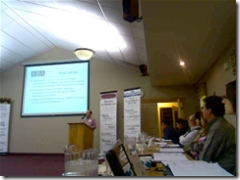RDA will be:
- Multinational content standard providing bibliographic description and access for a variety of media and formats collected by libraries today.
- Developed for use in English language environment; it can also be used in other language communities.
- Independence of format (i.e., like MARC21)
- Will support FRBR tags
- Enable users of library catalogs, etc., to find and user resources appropriate to their information needs.
Who develops and supports RDA:
- ALA CC:DA, ACOC, BL, CCC, CILIP, LC, etc.
“New” Part A (formally part I) for RDA:
- Introduction
- General Guidelines for resource description
- Identification of the resource
- Technical description — FRBR “Select”
- Content description — FRBR “Select”
- Terms of availability — FRBR “Obtain”
Item specific information(Now sprinkled through the proposal)
Chapters 6-7 — FRBR Find
- Relationships between FRBR and Group 1
- works
- expressions
- manifestations
- items
- Relationships between FRBR Group 1 and Group 2 entities
- persons
- corporate bodies
- families
“New” Part B
- General guidelines for Access point control
- Authorized forms
- Variant forms
Some “big issues”
- Its a compromise between AACR2 and what’s new.
- Means compatibility is important
- needed to maintain international agreements
- Content vs. display
- RDA will be a content, not display standard
- Transcription
- How important is data transcription to record identification?
Questions:
How many countries are involved in the RDA development?
US, Canada, UK and Australia.
–TR
